Ndola
| Ndola | |
|---|---|
| City | |
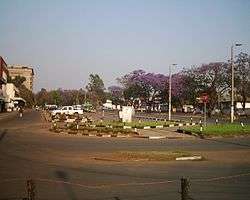 | |
| Nickname(s): NoliNoli | |
 Ndola Location in Zambia | |
| Coordinates: 12°58′00″S 28°38′00″E / 12.96667°S 28.63333°E | |
| Country |
|
| Province | Copperbelt Province |
| District | Ndola District |
| Elevation | 4,300 ft (1,300 m) |
| Population (2010 census) | |
| • Total | 455,194 |
| Climate | Cwa |
Ndola is the third largest city in Zambia, with a population of 455,194 (2010 census provisional). It is the industrial and commercial center of the Copperbelt, Zambia's copper-mining region, and capital of Copperbelt Province. It is also the commercial capital city of Zambia and has one of the three international airports, others being Livingstone and Lusaka. It lies just 10km from the border with DR Congo.[1]
History
Ndola was founded in 1904, by John Edward "Chiripula" Stephenson just six months after Livingstone, making it the second oldest colonial-era town of Zambia. It was started as a boma and trading post, which laid its foundations as an administrative and trading centre today.
The Rhodesia Railways main line reached the town in 1907, providing passenger services as far south as Bulawayo, with connections to Cape Town. The line was extended into DR Congo and from there eventually linked to the Benguela Railway to the Atlantic port of Lobito (which took some of Zambia's copper exports for many years with recent interruptions by closures; the rail line is now back in service). The Ndola railhead was responsible for the town becoming the country's centre of distribution. Before the road network was built up in the 1930s, a track from Ndola to Kapalala on the Luapula River, and boat transport from there to the Chambeshi River was the principal trade route for the Northern Province, which consequently formed part of Ndola's hinterland.
In 1961, an airplane carrying key United Nations figures, including the organisation's second Secretary General Dag Hammarskjöld, crashed on the outskirts of Ndola.
See Copperbelt Province for the history of the copper-mining industry.
Climate
Ndola has a moderate humid subtropical climate (Köppen Cwa).
| Climate data for Ndola | |||||||||||||
|---|---|---|---|---|---|---|---|---|---|---|---|---|---|
| Month | Jan | Feb | Mar | Apr | May | Jun | Jul | Aug | Sep | Oct | Nov | Dec | Year |
| Record high °C (°F) | 31.7 (89.1) |
33.1 (91.6) |
32.0 (89.6) |
32.4 (90.3) |
32.0 (89.6) |
30.2 (86.4) |
30.5 (86.9) |
33.5 (92.3) |
35.5 (95.9) |
36.1 (97) |
38.5 (101.3) |
32.6 (90.7) |
38.5 (101.3) |
| Average high °C (°F) | 26.6 (79.9) |
26.9 (80.4) |
27.4 (81.3) |
27.5 (81.5) |
26.6 (79.9) |
25.1 (77.2) |
25.2 (77.4) |
27.5 (81.5) |
30.5 (86.9) |
31.5 (88.7) |
29.4 (84.9) |
27.0 (80.6) |
27.6 (81.7) |
| Daily mean °C (°F) | 20.8 (69.4) |
20.8 (69.4) |
21.0 (69.8) |
20.5 (68.9) |
18.6 (65.5) |
16.5 (61.7) |
16.7 (62.1) |
19.2 (66.6) |
22.5 (72.5) |
23.7 (74.7) |
22.5 (72.5) |
21.0 (69.8) |
20.3 (68.5) |
| Average low °C (°F) | 17.1 (62.8) |
17.1 (62.8) |
16.5 (61.7) |
14.4 (57.9) |
10.8 (51.4) |
7.9 (46.2) |
7.8 (46) |
10.2 (50.4) |
13.6 (56.5) |
16.2 (61.2) |
17.1 (62.8) |
17.2 (63) |
13.8 (56.8) |
| Record low °C (°F) | 12.4 (54.3) |
12.4 (54.3) |
7.5 (45.5) |
7.2 (45) |
3.8 (38.8) |
1.7 (35.1) |
0.7 (33.3) |
1.6 (34.9) |
6.7 (44.1) |
9.8 (49.6) |
11.7 (53.1) |
11.2 (52.2) |
0.7 (33.3) |
| Average precipitation mm (inches) | 292.9 (11.531) |
249.0 (9.803) |
170.1 (6.697) |
45.5 (1.791) |
3.5 (0.138) |
0.7 (0.028) |
0.1 (0.004) |
0.4 (0.016) |
2.9 (0.114) |
31.5 (1.24) |
130.3 (5.13) |
305.9 (12.043) |
1,232.8 (48.535) |
| Average precipitation days (≥ 1.0 mm) | 23 | 20 | 17 | 6 | 1 | 0 | 0 | 0 | 0 | 4 | 14 | 23 | 108 |
| Average relative humidity (%) | 82.5 | 83.0 | 79.7 | 73.4 | 65.9 | 61.1 | 54.6 | 46.6 | 40.9 | 47.3 | 64.9 | 80.4 | 65.0 |
| Mean monthly sunshine hours | 151.9 | 142.8 | 192.2 | 243.0 | 279.0 | 276.0 | 297.6 | 297.6 | 279.0 | 269.7 | 207.0 | 158.1 | 2,793.9 |
| Source: NOAA[2] | |||||||||||||
Industry
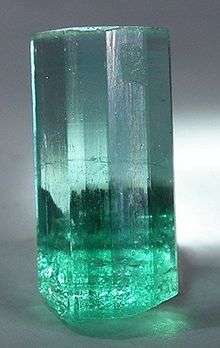
Legacy
Once the largest industrial centre of Zambia, boasting, among many high-powered sites, company facilities including a Land Rover vehicle assembly plant, Dunlop Tire manufacture, Johnson & Johnson, and Unilever, Ndola's economy shrunk significantly between 1980 and 2000. Many closed factories and plants lie unoccupied in the town. A number of former industries such as clothing and vehicle assembly have disappeared completely.[3] Even though the term 'ghost town' can no longer apply to it, Ndola is yet to regain its economic glory of pre-1980 days.
Refining
There are no mines in Ndola itself but the Bwana Mkubwa open-cast mine is only 10 km south-east of the city centre. Until their closure, copper and precious metals used to be brought from elsewhere in the Copperbelt for processing at the Ndola Copper Refinery and Precious Metals Refinery. Copper exports provide 70–80% of Zambia's export earnings, making the city very important to the country's economy.[1]
The Indeni Oil Refinery in Ndola supplies the whole country with refined petroleum. It was repaired in 2001 after being severely damaged by fire in 1999. GL Africa Energy, through its subsidiary Ndola Energy Company Limited, provides 105MW of power to the National Grid of Zambia. The power is generated from heavy fuel oil supplied by the Indeni Petroleum refinery.[4][5]
Commercial
Ndola is home to one of the country's national newspapers, the Times of Zambia, as well as its printer, Printpak. These run as one company called TimesPrintpak. Catholic church run printing press, Mission Press, is also located in Ndola. Mission Press operates as a commercial entity.
The headquarters for the Zambia Postal Service Corporation (Zampost)and workers compensation control board are located in Ndola. Zambias ultra modern stadium in Ndola accommodates most Zambia international sports events.
One mark of Ndola's commercial significance to Zambia is shown by the presence of the only major centre of operation for the country's central bank, the Bank of Zambia, outside of the capital, Lusaka. Every Major bank in Zambia has at least one branch in Ndola.
The largest insurance group in Zambia, ZSIC (pronounced 'zeesk'), own many commercial and residential properties in the city.
Limestone
Ndola has huge limestone reserves which are believed to be among the most homogeneous of their kind in the world. Limestone has therefore become to Ndola's economy what copper is to the rest of the country, providing much of the wealth and employment (Lime is a major component in the production of cement; a cement plant getting its lime from limestone and manufacturing a limestone cement will consume well over 80 kg limestone per 100 kg of cement it manufactures).
Between 1974 and 2009, Ndola supplied over 50% of Zambia's cement from a plant located some 5 km south-east of the heart of the city. This plant was called Chilanga Cement, Ndola Works. The parent company then was Chilanga Cement plc. Chilanga Cement ran two plants in Zambia: one built in 1949 and located at Chilanga (hence the parent company name) and the other built in 1969 and located at Ndola. In 2008, the new holding company, Lafarge Cement Zambia, completed construction of a brand new plant at Chilanga which would produce about double the volume of Ndola Works. By mid-2009, the new plant was still gathering momentum toward full production capacity, leaving Ndola still a significant player in the region's cement industry. Nonetheless, the combination of huge limestone deposits and existing transport infrastructure passing through Ndola has kept the city a very attractive destination for investment into cement and closely allied activities.
A second cement works is under construction in 2008.[6] In June 2009, countrywide advertisements were published to finalise staffing for this new cement plant.
Another important processing plant that is based on limestone in the area is Ndola Lime. It is Zambia's sole producer of Lime. Ndola Lime is located near the two cement manufacturing facilities. It supplies the mining industry as well as farmers who require agricultural lime. Ndola Lime company is wholly owned by ZCCM Investment Holdings, a parastatal holdings company via which Zambia's government maintains its active interest in the country's mining and closely related heavy industry.
Cultural Interactions
The four processing plants (the cement plants, the lime plant and Bwana Mkubwa) have mining rights on land located very close to the traditional Chiefdom of Chiwala. Chief Chiwala is therefore a significant interested party to Ndola industry and economics.
Electrical Engineering
Egyptian company Elsewedy Electric joined a consortium of local companies led by ZESCO Ltd (Zambia's electricity supply authority), and established a transformer manufacturing plant and an electrical meter manufacturing plant in Zambia in 2008. Both these facilities are located about 5 km south of Ndola city centre.
Transport
Ndola is on the Zambia Railways line with passenger and freight services running between Kitwe and Livingstone via Kabwe and Lusaka. Freight branch lines run to other Copperbelt towns and from Ndola to Lubumbashi in DR Congo via Sakania.[7]
A dual carriageway links Ndola to Kitwe, the Copperbelt's second city, and other tarred highways link to Mufulira and Lusaka.[7]
Ndola Airport has scheduled domestic services to Lusaka and an international service to Addis Ababa, Johannesburg and Nairobi.
The oil pipeline from Dar es Salaam terminates at the Indeni Oil Refinery in the town.
These factors make Ndola the distribution centre of the Copperbelt and northern Zambia.
Sport and recreation
As with many towns on the Copperbelt, Ndola's sports and recreation life was heavily supported by the now disbundled mining conglomerate, Zambia Consolidated Copper Mines Ltd (ZCCM). With the demise of ZCCM, many facilities deteriorated fast. Nevertheless, significant sports places are Ndola Tennis Club (membership), Ndola Swimming Pool (public), the Kanini area (about 3 km from city centre and home to several sports clubs and playing fields like Ndola Wanderers Football Club, a rugby club, and others). About 10 km north-west of the city centre, there is a motor racing track popular with weekend motorbike enthusiasts.[8] The city has several recreational green parks which enjoy a very basic level of maintenance and are open to the public. Of particular significance is the Dag Hammarskjöld Crash Site Memorial located some 10 km north of Ndola city centre. Dag Hammarskjöld Stadium, which was located on the banks of the Kafubu river south of the city, was razed in the 1980s. Its replacement, in the north-west of the city, is the Levy Mwanawasa Stadium with a seating capacity of 50,000. Ndola is home to Zesco United, a top-flight team in the Zambia Premier League. Zesco FC is nicknamed "team ya ziko", or the national team in the Nyanja language.
Education
The following are some of the education institutions found in Ndola:
- The Copperbelt University School of Medicine
- Northrise University
- Northern Technical College
- Ndola College of Biomedical Sciences
- Copperbelt Nursing Polytechnic
- St. Andrews High School
- Kansenshi Secondary School
- Chifubu Secondary School
- Kansenshi Basic School
- Ndola Primary
Features of interest
National monuments
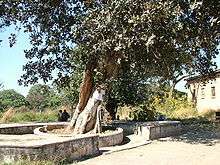
- The Slave Tree or Mukuyu Slave Tree around which Arab slave traders held slave markets in the nineteenth century (a mukuyu tree is a kind of fig tree). It has fallen due to "termites".[1]
- Dag Hammarskjöld Memorial ten kilometres along the Ndola/Kitwe road commemorates the site where the then United Nations Secretary-General died in a plane crash on September 18, 1961 during the Congo Crisis.[1]
- Lake Chilengwa 14 km E of Ndola at 12°58' S 28°45' E, was formed by the collapse of rock into an underlying limestone cavern, and has local cultural significance.[1]
Other features
- The Copperbelt Museum, with a collections of gems and minerals of the Copperbelt.[1]
- Small reservoirs formed by dams on the Kafubu and Itawa streams flowing through the south-east of the city are used for boating and recreation.[1]
The thermal power station which dominates the skyline near the railway station, built to power the mines and refineries, ceased operation in the 1960s when the Kariba Dam power station came on line.
Sister cities
-
 Aldershot, England, United Kingdom
Aldershot, England, United Kingdom -
 Blantyre, Malawi
Blantyre, Malawi -
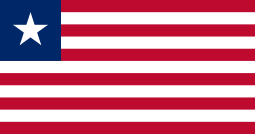 Bentol, Liberia
Bentol, Liberia -
 Porto, Portugal
Porto, Portugal -
 Regina, Saskatchewan, Canada
Regina, Saskatchewan, Canada -
 Makhachkala, Russia
Makhachkala, Russia -
 Harbin, Heilongjiang, China
Harbin, Heilongjiang, China -
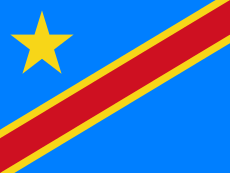 Lubumbashi, Democratic Republic of the Congo
Lubumbashi, Democratic Republic of the Congo -
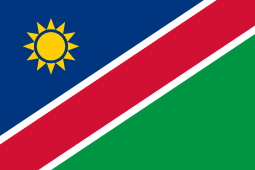 Walvis Bay, Namibia
Walvis Bay, Namibia
See also
References
- 1 2 3 4 5 6 7 Camerapix: "Spectrum Guide to Zambia." Camerapix International Publishing, Nairobi, 1996.
- ↑ "Ndola MET Climate Normals 1961–1990". National Oceanic and Atmospheric Administration. Retrieved January 16, 2014.
- ↑ BBC World Service Website: "The last shirt maker in Ndola". David Lyon, 22 May 2004. Accessed 18 March 2007.
- ↑ "Great Lakes Africa Energy | Our Projects". www.glaenergy.com. Retrieved 2017-04-05.
- ↑ "Great Lakes Africa Energy | Our Projects". www.glaenergy.com. Retrieved 2017-07-07.
- ↑ http://www.mmegi.bw/index.php?sid=4&aid=32&dir=2008/June/Thursday26
- 1 2 Terracarta/International Travel Maps, Vancouver Canada: "Zambia, 2nd edition", 2000
- ↑ Galpin, Darren. "Ndola". GEL Motorsport Information Page. Retrieved 24 April 2013.
External links
| Wikimedia Commons has media related to Ndola. |
-
 Ndola travel guide from Wikivoyage
Ndola travel guide from Wikivoyage
Coordinates: 12°58′S 28°38′E / 12.967°S 28.633°E
| | |||||||||
|---|---|---|---|---|---|---|---|---|---|
| Rank | Name | Province | Pop. | Rank | Name | Province | Pop. | ||
| Lusaka  Kitwe |
1 | Lusaka | Lusaka | 1 747 152 | 11 | Choma | Southern | 247 860 |  Chipata  Ndola |
| 2 | Kitwe | Copperbelt | 517 543 | 12 | Katete | Eastern | 243 849 | ||
| 3 | Chipata | Eastern | 455 783 | 13 | Kasama | Northern | 231 824 | ||
| 4 | Ndola | Copperbelt | 451 246 | 14 | Mazabuka | Southern | 230 972 | ||
| 5 | Lundazi | Eastern | 323 870 | 15 | Mansa | Luapula | 228 392 | ||
| 6 | Petauke | Eastern | 307 889 | 16 | Kafue | Central | 227 466 | ||
| 7 | Chibombo | Central | 303 519 | 17 | Mumbwa | Southern | 226 171 | ||
| 8 | Kalomo | Southern | 258 570 | 18 | Chingola | Copperbelt | 216 626 | ||
| 9 | Solwezi | North Western | 254 470 | 19 | Mpika | Northern | 203 379 | ||
| 10 | Kapiri Mposhi | Central | 253 786 | 20 | Mbala | Southern | 203 129 | ||